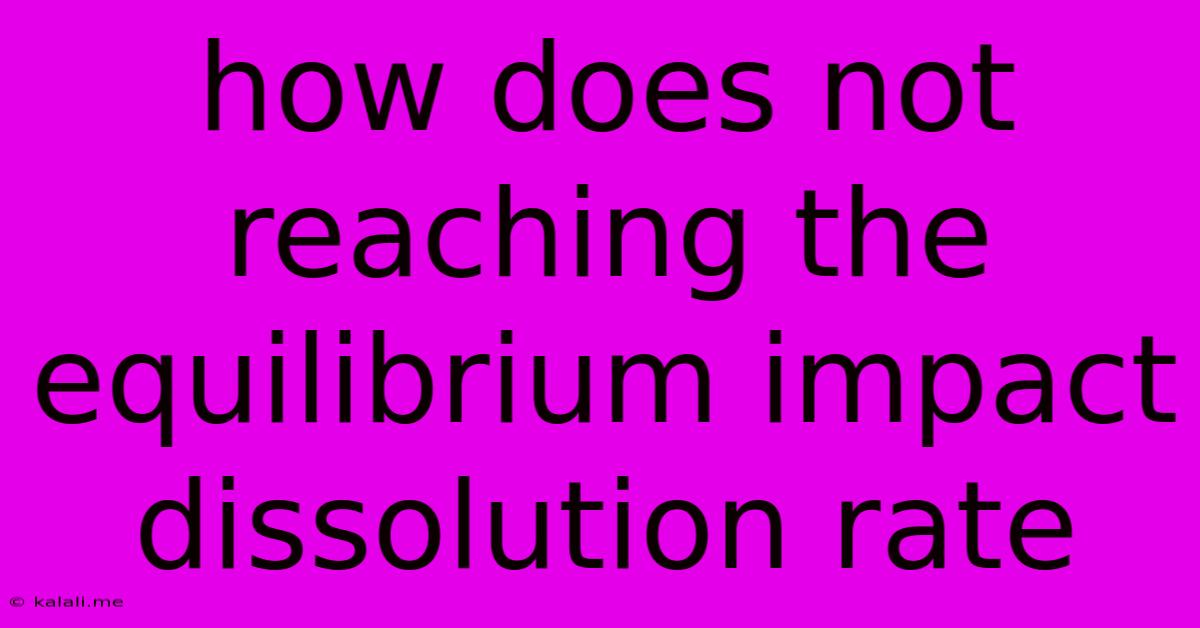How Does Not Reaching The Equilibrium Impact Dissolution Rate
Kalali
Jun 07, 2025 · 4 min read

Table of Contents
How Not Reaching Equilibrium Impacts Dissolution Rate
Meta Description: Discover how deviations from equilibrium affect the dissolution rate of a substance. Learn about factors influencing dissolution and the implications of incomplete dissolution in various applications.
Dissolution, the process by which a solid substance dissolves into a solvent to form a solution, is a dynamic equilibrium process. Understanding how this equilibrium is established and the implications when it isn't reached is crucial in many fields, including pharmaceuticals, environmental science, and material science. This article delves into the relationship between equilibrium and dissolution rate, explaining the factors that can hinder the achievement of equilibrium and their consequences.
Understanding Dissolution Equilibrium
Dissolution is governed by the principle of solubility – the maximum amount of solute that can dissolve in a given amount of solvent at a specific temperature and pressure. When a solute is added to a solvent, it initially dissolves rapidly. However, as the concentration of solute in the solution increases, the rate of dissolution begins to decrease. Simultaneously, the rate of precipitation (the solute coming out of solution) increases. Eventually, a dynamic equilibrium is reached where the rate of dissolution equals the rate of precipitation. At this point, the solution is said to be saturated, and the concentration of the solute remains constant.
Factors Affecting the Attainment of Equilibrium
Several factors can prevent a system from reaching equilibrium, thereby significantly affecting the dissolution rate:
-
Insufficient Contact Time: For equilibrium to be established, sufficient time must be allowed for the solute and solvent to interact thoroughly. If the contact time is too short, the dissolution process will be incomplete, resulting in a lower concentration of solute than predicted at equilibrium. This is often seen in rapidly stirred systems or processes where the solution is quickly removed from contact with the undissolved solute.
-
Limited Solvent Volume: A smaller solvent volume limits the amount of solute that can be dissolved before saturation is reached. In such cases, even with adequate time, the system may not fully dissolve the solute, preventing equilibrium from being achieved.
-
Temperature Fluctuations: Solubility is temperature-dependent. Changes in temperature during the dissolution process can disrupt the equilibrium, leading to either increased precipitation (if the temperature decreases) or increased dissolution (if the temperature increases). Maintaining a constant temperature is crucial for accurate and reproducible results.
-
Presence of Impurities: Impurities in either the solute or solvent can interfere with the dissolution process. They can physically obstruct the dissolution of the solute or chemically react with it, altering its solubility and preventing the system from reaching equilibrium. This is a major concern in pharmaceutical applications where the purity of ingredients is paramount.
-
Agitation/Mixing: While adequate agitation enhances the dissolution rate by increasing the solute-solvent contact area, excessive agitation can create conditions where equilibrium is not easily attained. This is particularly pertinent in situations where the solute dissolves slowly and precipitation occurs readily at the interface.
Impact of Not Reaching Equilibrium on Dissolution Rate
Failure to reach equilibrium directly impacts the dissolution rate in several ways:
-
Underestimation of Solubility: If equilibrium is not attained, the measured concentration of the solute will be less than its actual solubility, leading to an underestimation of the true solubility. This can have significant consequences, especially in drug development where solubility determines bioavailability.
-
Incomplete Drug Release: In pharmaceutical formulations, incomplete dissolution can lead to insufficient drug release and reduced therapeutic efficacy. This highlights the importance of designing formulations that ensure complete dissolution under physiological conditions.
-
Inaccurate Experimental Results: In research and analytical chemistry, failure to reach equilibrium can lead to inaccurate and unreliable results, affecting the validity and reproducibility of experiments.
-
Environmental Consequences: In environmental applications, incomplete dissolution can affect the bioavailability of pollutants and impact their transport and fate in the environment.
Conclusion
Reaching equilibrium is crucial for understanding and predicting dissolution behavior. Factors like contact time, solvent volume, temperature, impurities, and mixing all play a significant role in the attainment of equilibrium. Understanding these factors and taking steps to ensure their control are essential for obtaining accurate and reliable results in any application involving dissolution processes. Careful experimental design and control are crucial to minimize the impact of not reaching equilibrium and to obtain a reliable measure of the true dissolution rate.
Latest Posts
Latest Posts
-
Basement Flooded Water Heater Not Working
Jun 08, 2025
-
How To Find A Collision Force
Jun 08, 2025
-
What Numbers Add Up To 25
Jun 08, 2025
-
Drill Bit To Drill Through Stainless Steel
Jun 08, 2025
-
How Do You Say Check In In Spanish
Jun 08, 2025
Related Post
Thank you for visiting our website which covers about How Does Not Reaching The Equilibrium Impact Dissolution Rate . We hope the information provided has been useful to you. Feel free to contact us if you have any questions or need further assistance. See you next time and don't miss to bookmark.